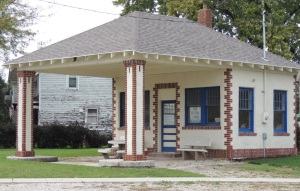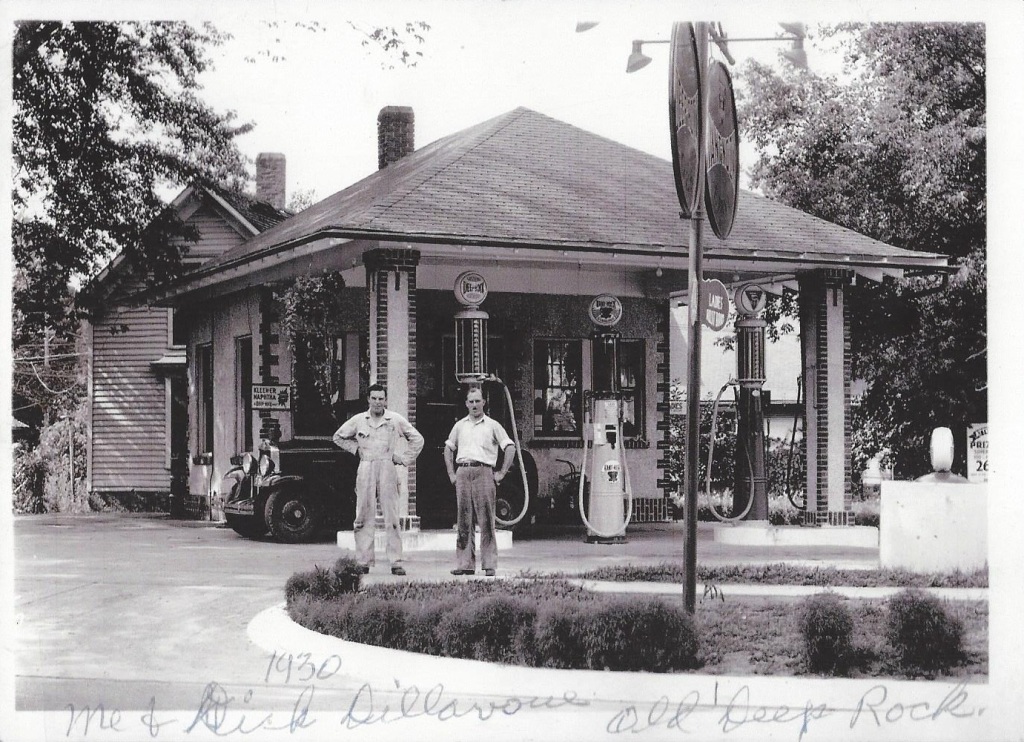~by Denise O’Brien Van
When Henry Ford’s first Model T rolled off his Detroit assembly line in 1908, it sparked a chain reaction of road construction and business enterprise.
Only 12 years later, six miles of the trans-continental Lincoln Highway were paved in Greene county, three miles east and three miles west of Jefferson, according to Bob Ausberger of the Lincoln Highway Assoc. By 1924, the highway was paved across the county.
With the popularity of affordable cars increasing (Ford manufactured 15 million Model Ts in 1927) and as highways were improved, gasoline, food and lodging facilities developed along the paved routes and streets.
 One of those early gas stations was Jefferson’s Deep Rock station, located on the northwest corner of Lincoln Way and Cedar Streets. Constructed in 1923, the building wasn’t far from the east edge of town. It existed as a service station into the 1990s.
One of those early gas stations was Jefferson’s Deep Rock station, located on the northwest corner of Lincoln Way and Cedar Streets. Constructed in 1923, the building wasn’t far from the east edge of town. It existed as a service station into the 1990s.
Now nearly a century old, the building, which had been an eyesore for more than two decades, seemed destined for demolition. The site was given to the city in early 2007. Nancy Teusch, a member of the city council at that time, saw potential in it. She thought the building’s historic nature and location near the Lincoln Highway’s east entrance to the town could make it a valuable potential tourist attraction as well an attractive enhancement to the city.
The property has since been renovated, funded by a 2009 $3,000 grant from the Greene County Community Foundation and by other contributions, including in-kind labor.
A celebration open house of the spruced-up site is set for Thursday, Oct. 9, from 5 to 7 pm.
“Nancy’s foresight made this project doable,” said city administrator Mike Palmer.
Using federal EPA “brownfield” funds, the Iowa Deparment of Natural Resources had removed the station’s seven underground tanks in 2006. The federal program cleans up contaminated sites that can then be redeveloped.
Don Van Gilder of the Greene County engineer’s office said the volume of the Deep Rock tanks ranged from 5,000 to 10,000 gallons, and included not only gasoline, but kerosene and diesel. Monitoring of the site continues.
The building’s white stucco exterior has been patched and painted by Jefferson’s Community Betterment Foundation volunteers. Its reglazed windows are trimmed in bright blue paint. The interior has been cleaned and painted. An addition on the west side of the building, which housed a hoist and a wringer washer for cleaning chamois used to dry and polish cars, was removed.
Palmer said plans are afoot to use the old Deep Rock as a passive tourist center, which means visitors could peer through the windows to see exhibits, or as a venue for small events.
A search is under way for a gas pump and a Deep Rock sign to place out front. Parking an antique car under the canopy would add to the site’s appeal, Palmer added.
Set at an angle on a 58- by 66-foot subdivided lot in a residential area, the station, built in the historic “canopy” style, had numerous owners and operators. Most operators leased the property and owned the business.
Early owners and/operators include Bert Reynolds who sold the station to two young Boone men in 1925. Mike Beckner, a longtime Jefferson service station operator, ran it with Dick Dillavou in 1930. Others were William Wallace, who offered car washes in what he called his “House of Service,” in the late 1930s; and Rusty Wilkins and Cecil and Harlan Calvert in the late 1940s. The final operator was Rod Eighmy, who gave it up in 1984. In its final days as a place of business in the early 1990s, Linda Eighmy ran a can and bottle redemption center
Paul McNulty bought the business in 1949, and he and Pete Garrity, who joined McNulty in 1953, had the longest run at the station, which became known as “Pete and Paul’s.” The two ran it for 25 years, McNulty driving the tank wagon and Garrity manning the station, until they retired in 1976.
McNulty’s and Garrity’s daughters, both of Jefferson, vividly remember the station in its heyday.
Colleen McNulty Guillman recalls riding along with her father as he delivered gasoline to surrounding farmsteads when most agricultural equipment was fueled by gasoline rather than by diesel. The gas was pumped into the tanker truck from the Deep Rock bulk gasoline site, located near the Milwaukee Road Railroad tracks a few blocks from the station.
And she, like a number of other former Jefferson kids, also remembers the famous candy machine, which accepted Canadian nickels, spit them out and still delivered the candy bar.
Mary Garrity Wolterman recollects that when the bell attached to the rubber hose that ran across the station’s driveway rang, “an actual person came out, pumped the gas, washed the windshield and the headlights, looked under the hood, checked the tires, and asked, ‘What else can we do for you?’”
That was service. Now the old station serves the community in a new way.

